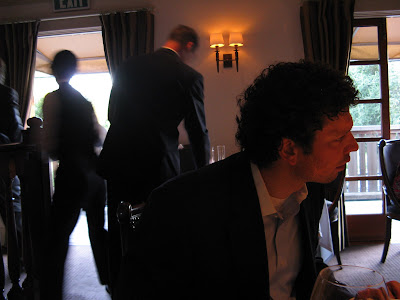 1) As much as any artist from the label's heyday, including more obviously transgressive peers such as Marvin Gaye, Jackson pushed against the strictures of the Motown machine, demanding creative freedom, room to grow and personal expression. The fact that he did so while still a child highlights his audacity.
1) As much as any artist from the label's heyday, including more obviously transgressive peers such as Marvin Gaye, Jackson pushed against the strictures of the Motown machine, demanding creative freedom, room to grow and personal expression. The fact that he did so while still a child highlights his audacity.2) His long history with plastic surgery and facial modifications (begun after a botched late-70s operation to fix a broken nose) eventually came to epitomize the worst trends of American desire - namely, not the quest for eternal youth or the perfection of beauty (a desire to some degree harbored by all cultures) but merely the need to possess the latest innovation, to stay eternally ahead of the curve, to defeat boredom through purposeless forward motion.
3) By crafting a masterpiece like 1979's "Off The Wall," yet seeing it stall at Number 3 on the Billboard Charts, Jackson recognized that black pop remained within a ghetto (of the mind, of the airwaves, of the home stereo system). One wonders if he winced at receiving the 1980 Billboard Top Black Artist and Top Black Album awards - not from any self-loathing of his ethnicity, but for the fact that his efforts clearly outshone such restrictive categories. He wasn't nominated for a Grammy that year - the Doobie Brothers' "What A Fool Believes" took home both best song and record, Billy Joel's "52nd Street" Best Album.
4) Jackson offered an unapologetically ambiguous approach towards masculinity, one continually in backwards flux. He slowly arrived at puberty after years of communicating through his pitch-perfect child's voice, only to later fade back into a pre-puberty state. This is still considered to be majorly transgressive in a culture that worships machismo.
5) His label as "The King of Pop", coined by Elizabeth Taylor (not exactly an expert on popular music) is on the one hand absurd, a mere marketing tool that fails to grasp the totality of his talent and vision, yet also perfect, in a way, by grasping "pop", not "rock" or "soul" or "r&B", as his fundamental goal and achievement. He was "pop" because you could shred along with Van Halen, nod your head along with Paul McCartney or bop in time with Quincy's arrangements .
6) His visual style trumped expression - or, better yet, his style was his expression, down to his military-fantasy overcoats and his symbolic sequin-festooned lone glove.
7) 1982's "Thriller" served as the perfect embodiment of the modern music industry's stake in global culture, in which individual tunes, whole albums and the artist themselves were sold as property and commodity to the youthful consumer. Add complex videos at the birth of MTV and mix in Reagan-era devotion to flash and celebrity, and one achieves cultural supremacy.
8) Whatever the truth of the allegations of child molestation and lewd behavior - and most are willing to admit the truth may never be fully uncovered - pedophilia charges seemed almost expected against somebody so clearly willing and daring enough to transcend the clearly-marked lines between youth and adulthood.
9) Similarly, the spectacle of Jackson's slipping ever further away from any recognizably adult relationship with the greater world stood as a reminder of the inherent creepiness latent in Disney, Peter Pan, circuses, cartoons - the possibility that never growing up would be a horror story rather than a fairy tale.
10) All the blather about "post-racial" societies seemed at least possible at times in relation to Jackson. Certainly his assertion that it "don't matter if you're black or white" seemed less absurd coming from a young man who'd achieved trans-racial world adoration and seemed determined to slip into a non-specific racial identity.
11) "Thriller," for all its dominance of the charts and absolutely irrepressible infectiousness, at times seemed too calculated to appeal to all musical types or to cut across all boundaries. With a dizzying array of styles and collaborators, it could seem an album by committee - the focus group approach to success. Yet why do we cry "sellout" or "calculation" for a black artist seeking wider approval, yet scold those white artists lacking broader sonic palettes? Could it have something to do with antiquated notions of "purity"?
12) To watch Michael Jackson dance in his prime was to see the possibilities of movement. He made one jealous of his limbs, his skinniness, his androgyny. He made me want to wear white socks and loafers, if only so I could bust a move.
13) By writing and performing "Don't Stop 'til You Get Enough," he achieved pop perfection - one of the greatest handful of radio minutes in this or any other era.
















































 Frog's Leap
Frog's Leap


























